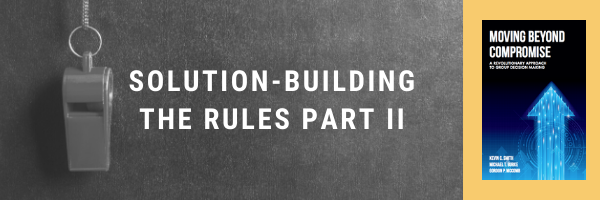
Solution-Building™: The Rules, Part 2
************
I apologize for being offline for the past two weeks. I have been dealing with the passing of my 103-year-old father. This involved making many decisions, both on my own and in consultation with my family and people we needed to work with outside the family. Some were easy and some difficult, but I did my best to follow the principles I am writing about in this blog. It helped keep me focused on the essentials and on easing the burden on others, as well as myself.
Now, back to Solution-Building, picking up where we left off.
************
Last time, I ended with this question:
“But,” you may also think, “what are the rules?”
There are two ways to answer this question. One is in terms of the operational Guidelines of Solution-Building. The other is a broader set of rules that govern our behavior in a group tasked with making a decision or solving a problem. The latter is the answer I will work with first since it is an important part of implementing the first guideline I introduced in the last post, which was:
Guideline Number One: Everyone plays by the same rules
For Solution-Building to deliver the most effective results, the entire team must be willing to work together to reach that result. To do that they must understand how to work together.
I spent some time on the concepts of commitment, objectivity, and courtesy in the past couple of entries in this series. These are important general principles that most people agree to be important. The problem is, they do not necessarily agree on how they are defined or to be practiced. As Hamlet says: “…ay, there’s the rub.”
How we define and use concepts is critical to being able to function as a group, no matter what the purpose of the group may be. I am a chemist and spent a number of years synthesizing new chemicals for testing as potential drugs. In chemistry we have very specific terminology, that is universally understood, to specify equipment, reagents, temperatures, amounts, times, volumes, and a host of other components of a synthetic process so that other chemists may duplicate, and confirm and even improve, the results. The language of chemistry is understood by practitioners of that science from all parts of the globe, and that understanding is consistent.
Every activity that involves a group in any way requires the same thing: a common understanding and consistent use of terms and concepts. If we do not have that understanding and consistency across the group, we will inevitably find ourselves working at cross-purposes.
As we go through the Guidelines, you will find that all of them fall under one or more of the basic concepts of commitment, objectivity, and courtesy. In the case of Guideline Number One, the basic concept under which it falls is commitment.
Guideline Number One, then, is the commitment that the group will function as a team, not a set of individuals acting independently. That there is an endpoint to be achieved, one that will be the most effective decision, solution, or result that can be reached, and one that everyone will support.
The fact is, this critical Guideline may perhaps be very difficult to get everyone in a group truly on board with. Why? Mainly because these concepts of commitment, objectivity, and courtesy can mean so many things to us.
It is impractical to try to begin any group decision-making or problem-solving effort with some sort of discussion of the group’s ground rules or defining terms like commitment, etc. However, the convener, or chair, or whomever is leading the discussions needs to make sure the group knows it is a team, with all the expectations that implies. One way is to spend some time defining the problem being considered and making certain everyone is on the same page as to the expected outcome. It is perfectly acceptable to remind the group that the discussions are expected to remain on point and civil and that the goal is to come to the most effective result. It is also appropriate to emphasize that the goal is a result that benefits the entire organization.
And, if they are using the principles of Solution-Building, the group can be reminded that those Guidelines will be a part of the operating rules. That, of course, assumes the entire group knows about the Guidelines. If they do not, the chair of the group may have to take an active role in guiding the way the discussions unfold.
The implementation of these Guidelines, beginning with the first one, will vary with the organization and the topic being addressed. Frankly, a strong leader of the group may be needed to make sure this first one will be maintained during the discussions. This, of course, implies that this leader is committed to the unified team approach to the task. By demonstrating this, by leading by example, the rest of the team is more likely to follow suit.
Next we will move on to the second Guideline.